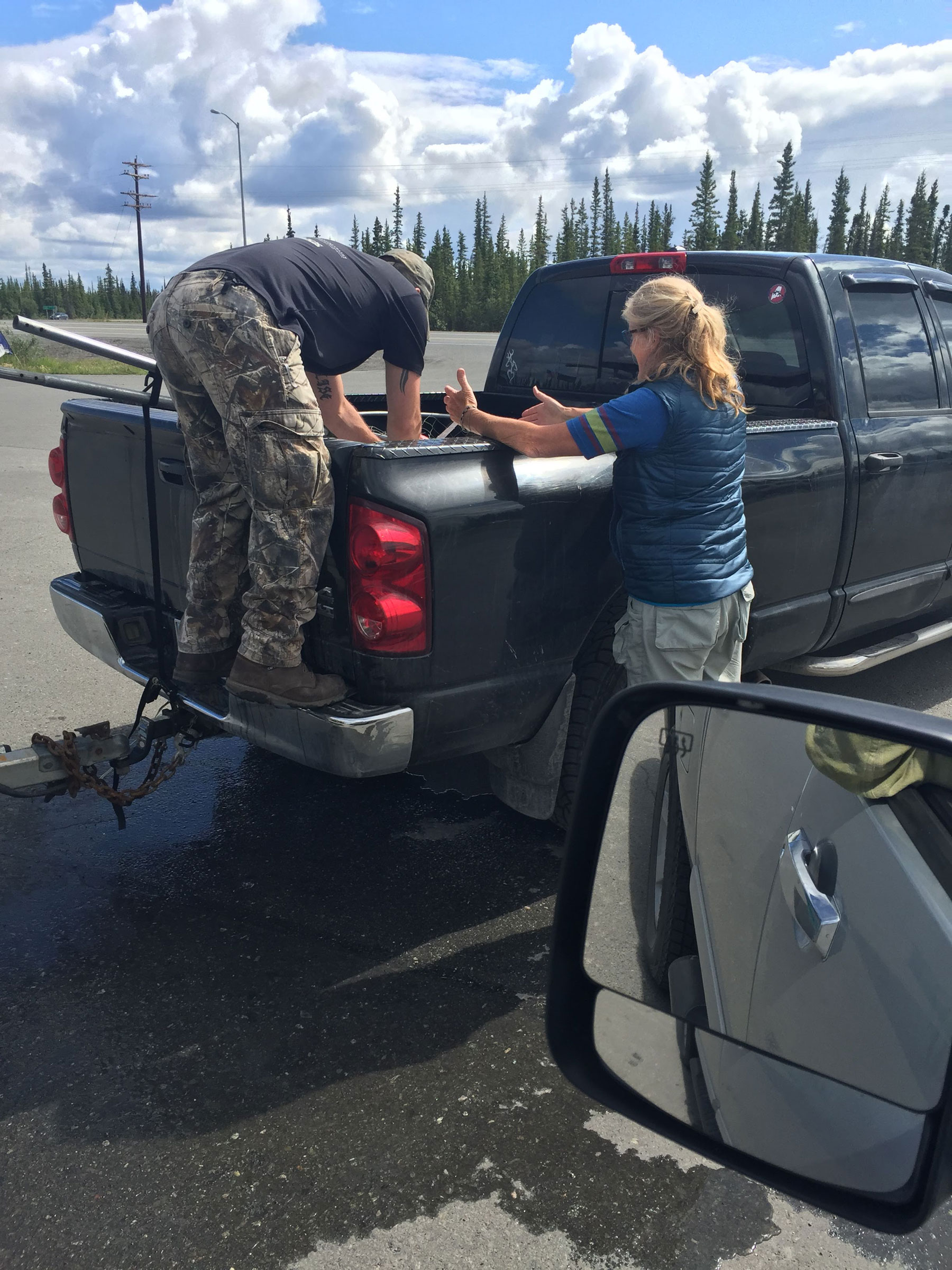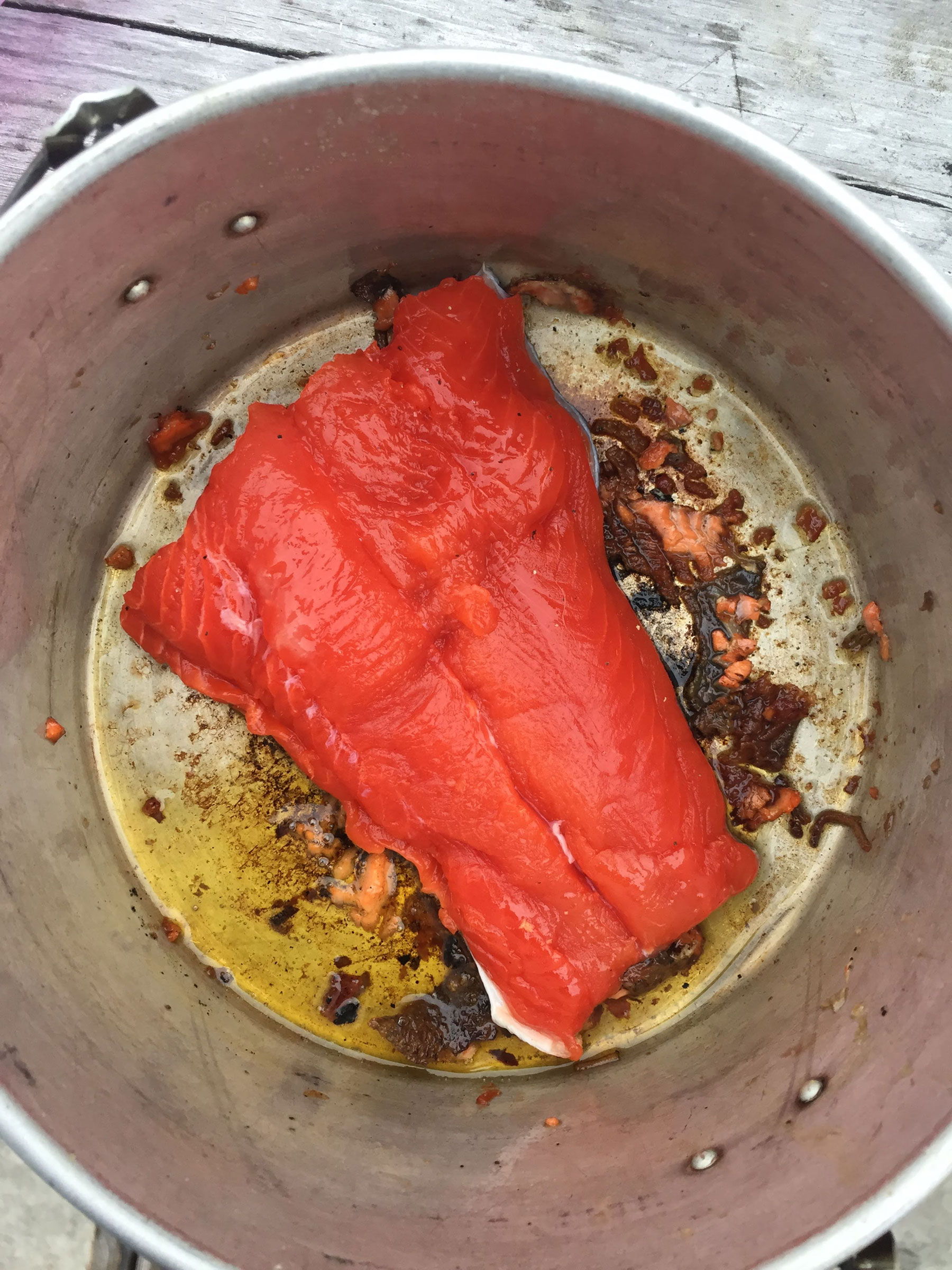Copper River Mother Lode

The Challenges and Rewards of Eating in the Alaskan Wilderness
by Lisa Ludwigsen
Doritos and Twinkies for lunch was a low point in our fast and furious tour of northern Alaska. But when you’re in the tiny town of Anaktuvuk Pass, in the heart of Gates of the Arctic National Park, deep within the Arctic Circle, you gratefully eat what is on hand. Fortunately, our Alaskan culinary adventure became much more appetizing in subsequent days.
I was tagging along on the painting odyssey of my friend, Mary Fassbinder. Mary was three years into an ambitious project to paint each of the nation’s 60 national parks. I was lucky to be invited along on visits to four of the eight Alaskan national parks. We visited Denali, then traveled into the Arctic Circle to the utterly remote Kobuk Valley and Gates of the Arctic national parks, which are accessible only by plane. In fact, Kobuk Valley has no roads, no rangers, guest quarters, or visitor centers—nothing except an undeniable and absolutely exhilarating wilderness. In order to paint that park, Mary chartered a single engine plane out of Fairbanks. Flying low for over six hours, I could not have imagined that this breathtaking landscape was so expansive. After a fast, short landing on the sculptural Great Kobuk Sand Dunes, Mary jumped out, quickly picked a spot, and started painting. This was the moment I truly understood Mary’s style of plein air painting—painting out in the open, recording a scene as it is right in the moment. We left Kobuk Valley a quick 1-1/2 hours later, headed for our next destination.
During those few days, food was clearly a secondary concern. We ate what was on hand, including that distantly familiar moist, creamy, and fluffy Twinkie. It had been decades since I had consumed one of those perennial Hostess delights.
Next up was Wrangell-St. Elias National Park, down a 66-mile dirt road winding through the Copper River watershed. Before jumping onto that long bumpy road, we fueled up at a gas station in the small town of Copper Center. It was here, amid the jumble of hunters, tourists, and locals, that the culinary aspect of our journey took a fortuitous turn. When looking for locations to camp or paint, it always helps to talk to the locals, and Mary is a gifted talker. The rig filling up ahead of us hauled a trailer laden with two dusty ATVs and two equally dusty camo-clad guys, who were heading home from a fruitful fishing trip where each of them had landed 60, yes 60, salmon. That’s world-renowned Copper River sockeye salmon! When Mary asked if they had any to spare, one friendly fellow reached into his cooler and handed us three gallon-sized ziplock bags filled with glistening, deeply orange, sweet-smelling filleted salmon. After days of food on the go, we did a little happy dance and headed to Wrangell.
So three car-camping Californians headed down a 66 mile dirt road to a place we’d never been, in a borrowed pick-up with very limited camping gear. Little did I know that I was about to enjoy one of the best meals of my recent life.
According to the Copperriver.org, a collective of Alaskan fishermen, “The Copper River is the birthplace of three wild Alaskan salmon species. The salmon live as adults in the Gulf of Alaska and the Pacific Ocean. Every year king, sockeye, and coho return to the Copper River to make the arduous 300-mile migration up the turbulent waters in order to spawn. Because the Copper River is so long and steep these fish must pack on sufficient fat reserves to fuel their epic journey— resulting in salmon rich in heart-healthy fatty acids and flavorful oils. The fish’s distinct regional DNA and lifecycle yield the world’s finest salmon.”
When these professionals describe the Copper River as turbulent, they aren’t kidding. As an explorer of our beloved Sierra Nevada and Northern California, I know clear running rivers, where fish are visible. Alaskan glacial rivers are quite different—brown, murky, rushing heartily downstream. I couldn’t understand how a fish could live in that ultra-murky water. Boy, was I wrong.
As soon as we were somewhat settled at our campsite along the chocolate milk colored, sediment-laden, rushing river draining from the Kennicott Glacier, Mary ventured out to paint, and I ventured into preparing dinner, while her husband, Dusty, made the fire. We were limited to just a tiny backpacking stove, vintage aluminum pot, salt and pepper, and a few basics from the cooler—olive oil, lemon, and parsley.
And here is where I learned the beauty of seared salmon, because our set-up did not allow for any subtleties; the old lightweight pot was either cold or screaming hot. What resulted was crispy skin and cooked flesh that transitioned to barely opaque pink interior. I tend to cook and eat simply, and this silky textured treasure from the wild waters needed no more than what we had available. We ate that fish for four days, for breakfast and dinner, and snacked on leftovers, folding the last remnants into an omelet in the kitchen of kind friends in Anchorage on my last day in Alaska.
Fortunately, Mendocino County shares a rich history and appreciation for our own salmon and steelhead varieties, and although river populations have been decimated due to a variety of man-made factors, there are some glimmers of hope and many environmental groups working to restore vital habitat. Sustainably caught ocean king and coho salmon can be found at Princess Seafood Market in Noyo Harbor and at the Ukiah Farmers Market. The Fish Peddler in Ukiah also sells local salmon.
And if you ever get a chance to visit ANY of our national parks or the Copper River, jump on it. The wild places are waiting for you!
To find out more about local salmon and steelhead populations, check out the Nature Conservancy’s extensive reporting at casalmon.org.
Follow Mary Fassbinder’s National Parks Painting Project at www.fassbindergallery.com.
Previous page: Center photo by Mary Fassbinder. Other photos by Lisa Ludwigsen.
Lisa Ludwigsen is marketing manager at Ukiah Natural Foods Co-op. For the last 25 years, she has worked with families, farms, and food through school garden programs, small scale farming, and the media.


